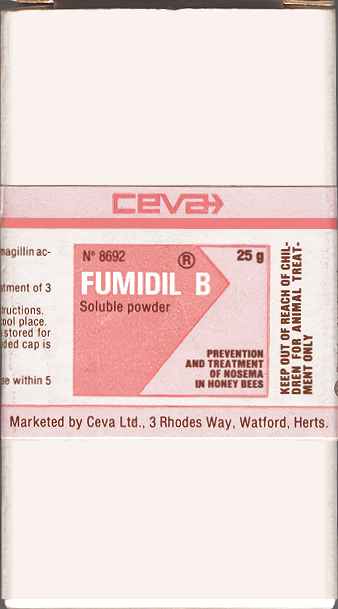| |
Fumidil 'B'
Fumidil 'B' is not registered for use in the U.K. It was withdrawn in 2012.
There will be many books, leaflets,
articles, etc in circulation for some years to come. As of December 2022 it is still available online from suppliers in other countries. Please don't be tempted to buy it as residues may be detected.
General note on chemicals: I do not endorse or advise on chemical treatments, as I am not qualified to do so and there may be dangers beyond my control. New
products may be introduced or existing ones withdrawn, so it is difficult to keep up with current information on a website such as this. As many of the chemical pages were generated by Dave Cushman, I am leaving the
content mainly as left by Dave for historical purposes only, which may mean information is out of date and unreliable. The user should seek guidance from other sources and satisfy themselves regarding safety and legality.
Roger Patterson.
|
|---|
|
For the prevention of Nosema disease in honey bees.
Manufactured By:- Abbott
Distributed & Marketed By:- CEVA Ltd., 3 Rhodes Way, Watford, Herts.
(to whom all enquiries should be addressed.)
Available from the UK
appliance trade.
Data Sheet Ref's:- PL 3974/4013, 09250/46/3, 09-250/79
Date of Issue of Data:- Unknown (thought to be 1979).
I neither endorse nor condemn this product. The information
as published here is a matter of public record. The information is
placed here for the education of those that wish to read it.
BEFORE you obtain or use the material concerned please ascertain the
legality of doing so in your location as the product may or may not be
approved in your geographic State or Country.
Fumidil B is Abbott's name for bicyclohexyl-ammonium
fumagillin:- a soluble salt of an antibiotic produced by fermentation
of Aspergillus fumigatus. This antibiotic has been
found to possess a specific activity against the protozoon
Nosema Apis, the cause of Nosema disease in
honey bees.[1] The antibiotic prevents the reproductive
stages of the parasites from attacking the epithelial cells of the
digestive stomach of the bee.
The 3 colony pack shown at right contains a polythene tub
with a 'lever off' lid. The fine, but granular powder contained in the
tub has a cream colouration.
| |

|
|---|
Fumidil B has no effect on the spores or the resting stage
of Nosema Apis, and must therefore be made
available in the food of the bees for three to four weeks to free the
colony population of infection. To prevent reinfection from spores
carried by the combs the latter should be replaced by clean combs
early in the spring and then (the old combs) should be decontaminated
by exposure to the vapour of commercial formalin (or
glacial acetic acid if they contain stores of honey
or pollen) before they are used again.[2]
Fumidil B is effective when fed in syrup in the autumn.
[3] It is best used then as a preliminary to the transfer of
the bees on to clean combs in the spring or as a precautionary measure
in the autumn following the transfer.[4]
References
- [1] Katznelson, H., and Jamieson, C.A. (1952) Control of
Nosema Disease in Honey Bees with Fumagillin, Science, 115: 70.
- [2] Bailey, L. (1954), The Control of Nosema Disease, Bee
World 35: 111.
- [3] Bailey, L. (1953), The Treatment of Nosema with Fumagillin,
Bee World 34: 136.
- [4] Bailey, L. (1963), Infectious Diseases of the Honey Bee,
p.110 (Land Books, London).
Directions for use
Based on results obtained at the Rothamstead Experimental Station.
Each colony to be treated should receive approximately 166 mg of
fumagillin activity (one third of the contents of a 0.5 gm vial),
administered in a syrup containing 14 lb of sugar in 7 pints of water.
Precise measurement is not essential since a "rough third" of the
0.5 gm vial (approx. a desert spoonful) is more than adequate for the
treatment of the average colony.
It is easier to dissolve sugar in warm water, however it is important
that Fumidil B is NOT subjected to a temperature
higher than 49 deg C (120 deg F) during any stage of the mixing
operation.
- 1. Heat 7 pints of water per colony to 38 deg C (100 deg F)
DO NOT EXCEED 49 deg C (120 deg F).
- 2. Apportion one third of the 0.5 gm vial for each colony to be
treated and dissolve in the heated water.
- 3. While the water is still hot add 14 lbs of sugar per colony and
stir to make a clear syrup. (Take note of the final volume to make
step 4 easier.)
- 4. Feed this syrup to the bees in the usual way.
NOTE
The large pack contains 9.5 gm of fumagillin activity which makes
sufficient syrup to treat 54 colonies. The contents of this pack
should be dissolved in 47.5 gallons of water to which 6.75 cwt. of
sugar should be added as described above.
How Supplied
Fumidil B List No. 8692 (in a suitable buffered formula) is
supplied in two pack sizes:
- Small pack: representing 0.5 gm of fumagillin activity (25 gm
of soluble powder). Sufficient for the treatment of 3 colonies.
- Large pack: representing 9.5 gm of fumagillin activity, sufficient
for the treatment of 54 colonies.
Dave Cushman.
Originally written by Dave Cushman. Edited by Roger Patterson.
Page created pre-2011
Page updated 13/12/2022
